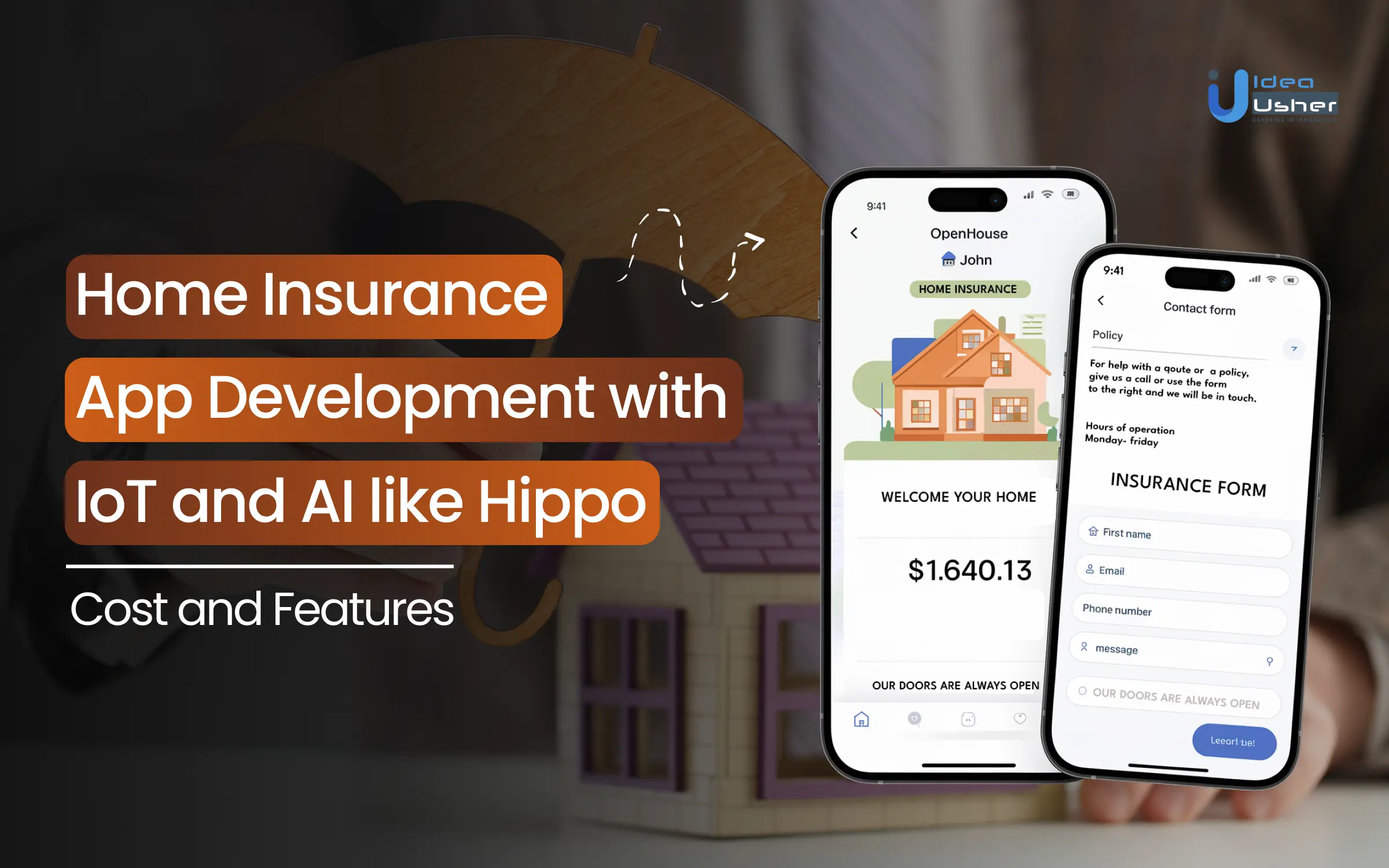As homeowners face increasing concerns about property security and risk prevention, the need for smarter, more responsive insurance solutions is greater than ever. Traditional home insurance policies often need to improve in offering proactive measures, leading to lengthy claims processes after damages have occurred. Home Insurance App with IoT and AI like Hippo are here to fill this gap, providing real-time monitoring, predictive insights, and enhanced personalization. By integrating smart devices and data-driven alerts, these apps empower homeowners to mitigate risks and streamline the claims experience, offering a more dynamic approach to home protection.
With the global IoT insurance market projected to grow at over 40% CAGR in the coming years, insurers are increasingly investing in smart tech to improve customer experiences and reduce overall risk. The home insurance market is undergoing a transformative shift, fueled by advancements in IoT and AI technology. This blog will explore the steps for developing a home insurance app that utilizes IoT and AI, covering essential features, cost implications, and the necessary tech stack to compete with leaders like Hippo. Whether you’re a developer, business owner, or industry professional, this guide will provide valuable insights into creating a modern home insurance solution that meets the demands of today’s tech-savvy homeowners.
Key Market Takeaways of Home Insurance Apps
Source: GrandViewResearch
Customers now seek insurance products tailored to their unique needs and preferences. Insurers are responding with flexible, expanded coverage options. Growing demand for comprehensive coverage and increased risk awareness drive home insurance adoption. These trends are expected to fuel market growth over the forecast period.
Rising urbanization and expanding residential real estate are key drivers of home insurance market growth. As urban populations increase and home investments grow, demand for home insurance rises. This trend is especially strong in developing areas with rapid urban development. Increased homeownership and the need for financial protection significantly boost the home insurance market.
Work with Ex-MAANG developers to build next-gen apps schedule your consultation now
Overview of Home Insurance App with IoT and AI like Hippo
Hippo is an innovative home insurance provider that leverages technology to offer a modern, customer-centric approach to home protection. Founded to simplify the insurance process, Hippo combines data-driven insights with digital tools. It provides policies customized to each homeowner’s unique needs. By integrating IoT devices and AI, Hippo goes beyond traditional insurance. It promotes proactive risk management and preventive care. This helps homeowners avoid common issues before they lead to costly claims.
Key Features of Home Insurance App with IoT and AI
- Real-Time Risk Monitoring: IoT sensors detect issues like leaks, smoke, or movement, alerting homeowners to risks.
- Predictive Maintenance Alerts: AI analyzes data to predict maintenance needs, helping prevent costly repairs.
- Personalized Policy Recommendations: The app customizes coverage based on home and lifestyle data, offering tailored protection.
- Proactive Claims Processing: Users file and manage claims, with AI speeding up processing and automating documentation.
- Risk Assessment and Premium Discounts: IoT data helps assess safety, potentially lowering premiums with reduced risks.
- 24/7 Emergency Support: Instant access to emergency support services through the app for quick guidance.
- Usage-Based Premium Adjustments: AI adjusts premiums based on real-time risks and usage, giving homeowners control.
- Data-Driven Home Insights: Reports provide insights into home usage, energy efficiency, and risks, helping homeowners improve.
Are Home Insurance Apps with IoT and AI like Hippo Profitable?
Home insurance apps enhanced with IoT and AI, like Hippo, offer a lucrative opportunity for entrepreneurs and businesses aiming to disrupt the traditional insurance sector. By combining smart technology with data-driven risk management, such platforms not only streamline insurance services but also create multiple profitable avenues. With IoT devices actively monitoring homes for risks such as leaks or smoke, platforms can significantly reduce the frequency and severity of claims. Lower claims translate into higher profitability as insurers can manage risks more effectively, improving the overall loss ratio. Additionally, platforms leveraging AI can use data insights to refine policies, offering highly customized premiums that attract diverse customer bases and provide consistent revenue.
Entrepreneurs can also capitalize on the preventative aspect of IoT-driven platforms, positioning their product as a value-added service beyond typical insurance. These services justify slightly higher premiums, as they offer users more than just protection. They provide proactive home care, which many consumers are willing to pay for. By partnering with smart device manufacturers, a platform like this could also offer bundled IoT packages, creating additional revenue streams. Furthermore, platforms with AI and IoT can reduce operational costs by automating customer service, claims, and policy adjustments, driving down overhead and increasing profit margins. This approach not only attracts tech-savvy customers but also builds brand loyalty, making these platforms highly profitable in a competitive insurance market.
Business Model Of Home Insurance App with IoT and AI like Hippo
Home insurance apps like Hippo utilize a technology-driven business model that combines IoT and AI to deliver proactive, personalized services. This approach offers real-time monitoring and predictive insights, setting them apart from traditional insurance providers by adding value through risk prevention.
1. IoT-Enabled Risk Monitoring
These apps incorporate IoT devices to monitor home conditions, such as temperature, water leaks, and security. Real-time data from smart sensors enables proactive alerts to prevent damage. This helps reduce claims and allows insurers to offer discounts for safer homes.
2. AI-Based Risk Assessment
AI algorithms analyze data from IoT devices to evaluate risks and detect patterns. This analysis helps insurers predict potential issues, offering personalized recommendations to policyholders. As a result, customers receive more relevant, data-backed coverage options.
3. Direct-to-Consumer Model
Apps like Hippo use a direct-to-consumer model, selling policies directly to users without intermediaries. This approach lowers costs and enhances customer relationships. It allows policyholders to access affordable, streamlined insurance without traditional brokerage fees.
4. Revenue from Premiums and IoT Partnerships
Revenue is primarily generated from insurance premiums, with added value from IoT partnerships. Hippo collaborates with IoT device providers to offer customers discounted smart home products. These partnerships strengthen the brand while encouraging policyholders to adopt preventive solutions.
What is Usage-Based Insurance IoT?
UBI powered by the IoT is an innovative model that adjusts insurance premiums based on real-time data collected from connected devices, such as vehicles or wearable technology. Through IoT sensors, UBI monitors factors like driving habits, mileage, speed, and even how often a person engages in specific activities. This data is transmitted to insurers, who then analyze it to offer personalized policies that reflect the actual risk associated with an individual’s behavior. For example, drivers who demonstrate safe driving patterns may receive lower premiums compared to those with riskier habits, making UBI a more tailored and dynamic approach to insurance.
The integration of IoT in UBI also provides numerous benefits for both insurers and policyholders. It encourages safer behaviors, as individuals are motivated to adopt habits that lower their risk to reduce their premiums. Additionally, it enables insurers to more accurately assess risk based on real-world data rather than relying on general statistics or outdated models. This means policyholders can save money by controlling their insurance costs through their actions. For insurers, UBI improves the efficiency of risk management, allows for more competitive pricing, and offers the ability to innovate in customer service, creating a more dynamic and customer-focused insurance experience.
Steps to Develop Home Insurance App with IoT and AI like Hippo
Creating a home insurance app that integrates IoT and AI, like Hippo, requires a strategic blend of technology, data, and user experience design. Here are eight unique steps to help you develop a successful platform.
Step 1: Identify Core Insurance Services and Features
Start by defining the essential insurance services your app will offer, such as coverage options, claim management, and preventive maintenance features. A clear scope ensures the app delivers core functions that attract and retain users.
Step 2: Establish IoT Device Partnerships
Partner with IoT device manufacturers to enable in-home monitoring for risks like leaks, fires, and security breaches. These partnerships allow you to offer bundled packages or discounted devices to enhance customer adoption.
Step 3: Develop AI-Driven Risk Assessment Models
Create AI models that analyze data from IoT devices, user profiles, and historical claims to assess and predict potential risks. This predictive capability allows for proactive alerts and personalized insurance premiums.
Step 4: Integrate Real-Time Monitoring and Alerts
Enable real-time monitoring by connecting the app with IoT sensors to provide instant alerts for detected risks. Timely notifications help homeowners take preventive measures and reduce the likelihood of claims.
Step 5: Design an Intuitive and User-Friendly Interface
Build a simple, intuitive user interface that provides easy access to claims, policy details, and IoT device insights. An accessible design enhances user engagement and satisfaction with the app.
Step 6: Implement Efficient Claims Automation
Automate the claims process using AI to streamline document collection, verification, and status updates. An automated claims system speeds up processing and improves user experience by reducing manual intervention.
Step 7: Ensure Data Security and Compliance
Implement robust data security protocols and comply with regulations like GDPR to protect user information. Ensuring privacy and security builds trust, especially when sensitive home data is involved.
Cost of Developing Home Insurance App with IoT and AI like Hippo
| Cost Component | Description | Estimated Cost Range |
| Research and Development | IoT integration, AI model training, data acquisition | $2,000 – $8,000 |
| Front-End Development | UI/UX design, front-end development, responsive design | $3,000 – $10,000 |
| Back-End Development | Server setup, API development, database integration | $5,000 – $15,000 |
| IoT and AI Features | Smart home monitoring, predictive maintenance, real-time alerts, data analysis | $10,000 – $25,000 |
| Security and Compliance | Data encryption, user authentication, regulatory compliance | $2,000 – $5,000 |
| Testing and Quality Assurance | IoT device testing, integration testing, UAT | $1,000 – $3,000 |
| Total Cost Range | $10,000 – $100,000 |
Factors Affecting the Cost of Developing Home Insurance App
- Complexity of IoT and AI Integration: The level of IoT integration, such as smart device compatibility and data processing capabilities, significantly impacts costs. Advanced AI features for predictive maintenance and real-time risk assessment add complexity and require more development resources, increasing expenses.
- Data Security and Compliance Requirements: Home insurance apps handle sensitive user information, so ensuring data security and compliance with regulations like HIPAA or GDPR adds to the cost. Implementing strong encryption user authentication, and meeting regulatory standards requires specialized expertise and secure infrastructure.
- Customization and Feature Depth: The number and sophistication of features can affect the budget. Personalized policy recommendations, real-time alerts, and user-friendly dashboards are examples. Customizing the app for a unique experience will also increase development time and expenses. Adding features like chatbot support or claims management will further raise costs.
Conclusion
In my opinion, developing a home insurance app with IoT and AI capabilities, like Hippo, presents an excellent opportunity to modernize and improve the insurance experience. Utilizing IoT for real-time monitoring and AI for predictive risk assessment, these apps offer homeowners proactive protection and valuable insights for insurers. This combination leads to smarter policies, personalized coverage, and faster claim processing, making insurance more responsive and efficient. For businesses entering this space, focusing on user-centric design, IoT integration, and data security is crucial. A well-designed home insurance app with IoT and AI can meet the needs of tech-savvy homeowners and deliver real value.
How Can Idea Usher Help?
At Idea Usher, we specialize in developing cutting-edge home insurance apps with IoT and AI capabilities, just like Hippo, to help you revolutionize the insurance experience for your users. With over 500,000 hours of coding experience in app development, our team has the expertise to seamlessly integrate smart home devices, real-time monitoring, and predictive analytics to offer personalized, proactive insurance solutions.
We understand the importance of innovation, security, and user experience, and we are here to help you create an app that meets the needs of today’s tech-savvy homeowners while boosting your business efficiency. Let us turn your vision into a game-changing reality!
Work with Ex-MAANG developers to build next-gen apps schedule your consultation now
FAQs
How does IoT improve the functionality of a home insurance app?
IoT enables real-time monitoring of a home’s condition, such as detecting leaks or fire hazards, which allows insurers to assess risk more accurately and offer proactive solutions. It also helps users prevent potential damage, leading to fewer claims and more affordable premiums.
What role does AI play in a home insurance app like Hippo?
AI uses data analytics to predict risks, offer personalized policy recommendations, and streamline claims processing. By analyzing patterns and user data, AI can optimize coverage options, making the insurance process more efficient and tailored to individual needs.
How much will it cost to develop a home insurance app with IoT and AI?
The cost of developing a home insurance app with IoT and AI can vary depending on the complexity of features, the number of IoT devices integrated, and the AI model used. However, you can expect a cost range between $10,000 and $100,000, depending on your specific requirements.
What are the key features of a home insurance app like Hippo?
Key features include smart home device integration, real-time risk assessment, personalized policy recommendations, claims management, and 24/7 support. These features help users monitor their homes, receive proactive alerts, and manage their insurance coverage with ease.






















